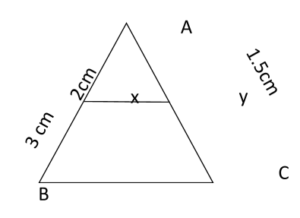Once you have understood the idea of points, lines, and planes, the next thing to explore is what occurs when two lines or rays meet at a point, forming an angle between them.
Angles are used throughout geometry, to define structures such as polygons and polyhedrons, and to explain the behavior of lines, so it’s a good idea to become familiar with some of the vocabulary, and how we measure and describe angles.
Generally speaking, a line is defined as a one-dimensional geometric form that has only length and no width. A straight line is defined as a line that runs indefinitely in any direction with no ends, and its equation is ax + b = 0.
Angles
Angle is formed due to the intersection of two parallel lines. On the basis of measurement, we have 6 types of angles –
- Acute angle
- Obtuse angle
- Right angle
- Straight angle
- Reflex angle
- Complete angle
Acute angle
An acute angle is an angle that is greater than 0° and less than 90° or we can say that is lies between 0° to 90°.
Obtuse angle
An obtuse angle is an angle that I greater than 90° but less than 180°. We write it as 90°<<180°. This means angle (θ) lies between 90° < < 180°.
Right angle
The angle equal to 90° is known as a right-angle triangle.
Straight angle
The angle whose value is equal to 180° is known as the straight angle.
Reflex angle
The angle which lies between 180° and 360° is known as the right angle. We may write it as 180°<θ<360°.
Complete angle
The angle has a value equal to 360° is known as the complete angle.
Lines
- Horizontal lines
- Vertical lines
- Oblique lines
- Parallel lines
- Perpendicular lines
Horizontal lines
From left to right, a horizontal line can be drawn. It moves along the x-axis without coming into contact with any points. Horizontal lines include the line that separates the ocean from the sky (the horizon), the lines on a sheet of notebook paper, and the border of a table, to name a few examples.
Vertical lines
A vertical line is a line that runs vertically up and down the page. In the same way that horizontal lines never contact a point on the y-axis, vertical lines never touch a point on the y-axis either. Vertical lines can be found in a variety of places, including architectural pillars, tree trunks, and the lines of a skyscraper.
Oblique lines
Oblique lines are straight lines that are not parallel to the horizontal or vertical axis. These lines do, in fact, cross both the x and y axes. When an oblique line connects two vertices of a polygon, the line is referred to as a diagonal line in mathematics.
Parallel lines
Parallel lines are lines that run next to one other without ever meeting or colliding. Horizontal, vertical, or oblique lines are examples of this. These lines are always the same distance apart (also known as equidistant), and they stretch into infinity without ever meeting. Parallel lines are represented by the symbol ||, and they can be found in striped clothing, fence posts, or any other set of lines.
Perpendicular lines
In geometry, perpendicular lines are formed when a vertical line crosses across a horizontal line and forms a 90-degree angle with each other (also known as a right angle). Perpendicular lines are represented by the symbol, and you’re most likely to encounter them on a grid or where lines come together to form a T shape.
In contrast to perpendicular lines, which can only meet at 90°, intersecting lines are lines that meet at any angle at a given point.
secant lines are defined as follows: – lines that cross a curve at two or more locations in the same direction
lines that are skewed – lines that do not overlap with one another yet are not equidistant from one another (unlike parallel lines)
parallel lines tangent to one another – lines that cross over a curve at a single point.
Conclusion
Angles are formed due to the intersection of two parallel lines. On the basis of measurement, we have 6 types of angles – acute angle, right angle, obtuse angle, complete angle and reflex angle. The angle that lies between 180° and 360° is known as the straight angle. Vertical lines are lines that never touch a point on the x-axis or y-axis. They are also known as perpendicular lines because they can only meet at 90°. Oblique lines, parallel lines, and intersecting lines are all examples of this.
 Profile
Profile Settings
Settings Refer your friends
Refer your friends Sign out
Sign out




